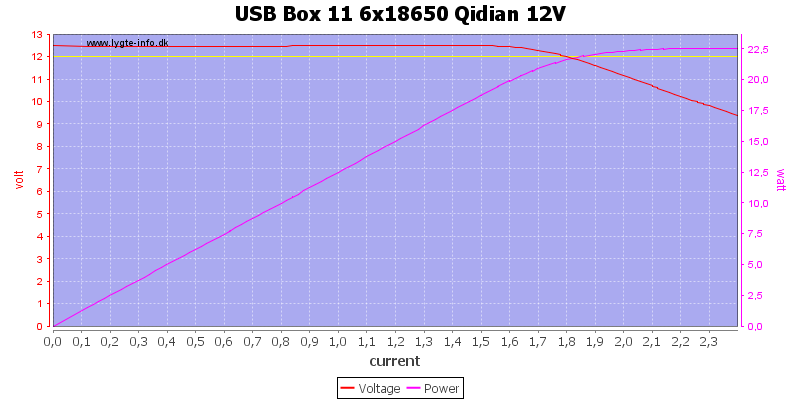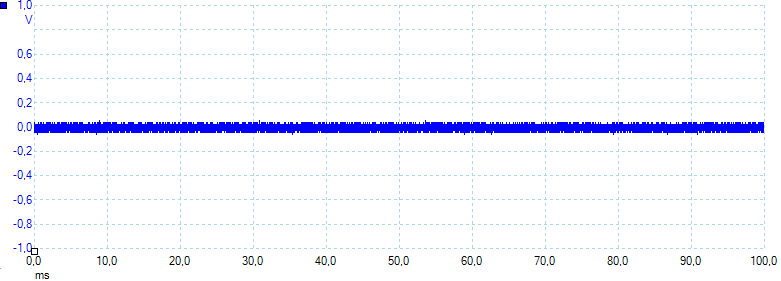USB battery box 6x18650 Qidian

I got this box from fasttech.
Official specifications
- Color: Black
- Material: ABS
- Battery Form Factor: 18650
- Required Battery Count: 6
- Brand: QIDIAN
- Dimensions: Depth 24.8 mm, Height 183 mm, Width 92 mm
Product Weight 163 g - Power pack input: DC 5V, 2A
- Power pack output: DC 5V / 2A (USB 1), DC 5V / 1A (USB 2), DC 3.7V / 4A (OUT M), DC 5V / 2A (OUT M), DC 9V / 1.5A (OUT M), DC 12V / 1A (OUT M)
How does it look

![]()

I got the box in a retail package, labeled in Chinese (I suppose).

Because it is for 6 batteries, the box is fairly long.

The box has 3 output, two USB and on DC connector output with selectable voltage (5V/9V/12V).
The input is a also a DC connector.
The DC output connector is outer ø4 mm and inner ø1.6 mm, 11mm long.

The leds has a couple of functions: they show selected output voltage and battery charge state.

The switch is not a on/off switch as labeled, but a auto/manual power off switch.
In the off position the box must be manually turned off, in the on position it will turn off when load is removed.


It is a bit difficult to load the box with 6 batteries, due to the pressure from the 6 springs, the minus rail has a tendency to slide up.
Due to this it is best to use unprotected flat top batteries.

Removing two screws and it is possible to remove the electronic. There are two push button on the electronic board, not only the one on the outside of the box. There is also a reset switch, that is used to reconnected the batteries when they are replaced (A charger will also do that).


Measurements
- DC connector does never turn off it will output at bit less than the battery voltage when box is off.
- When 5 volt output is selected, both usb and DC connector supply 5 volt.
- When 9 or 12 volt is selected the usb output is off.
- A single press on the button will turn the box on.
- Hold the button to step from 5 to 9 to 12 volt, then to off, the only works when nothing is connected to the output (Button has to be released between steps). The actual voltage is shown on the blue leds.
- On/off switch on side of box is an auto off button when placed in on position.
- The auto off will disconnect loads at 136mA after 14 seconds.
- When batteries has been replace, use the internal reset switch or charge the box to activate it.
- When off the current consumptions is 55uA (This is insignificant).
- With battery disconnected the current consumption is about 20uA.
- When on without any load the current consumption is 17mA (About 45 days with 6 3100 mAh batteries).
- It is very difficult to load a full set of batteries, the rails often pops up.
- One output (USB1) is coded as Apple 2A
- One output (USB2) is coded as USB DCP
- A short press on the button when output is on will display a battery gauge on the 5 blue leds (I could not measure the voltage steps).
- When output is on, one of the blue leds is on.

The 5 volt output is rated for 2A, but does not turn off, even at 4A. At 2A and below the output voltage is within specifications.

The 9V output is rated at 1.5A and does easily deliver that.

12V output is only rated for 1A, but again it can deliver considerable more.
.png)
The sweep looked nice, what about constant load? Here I have tested at 2A and it hold the 5 volt output voltage for nearly 6 hours.
It also has a good efficiency for a 2A output.
.png)
With 9 volt and 1.5A the DC output can hold 9 volt for more than 3½ hours, but it does not turn off when the batteries are low!
At 220 minutes the output voltage drops down to 3 volt and it continues to supply power at 3 volt and 0.5A, until the battery voltage is down to about 2.5 volt, where the battery is disconnected.
The current draw might look huge at 5A, but with 6 batteries it is a light load for the batteries.
Because the voltage drops down to 2.5 volt, it is best to use Panasonic 2900/3100/3400 mAh batteries, that are rated for discharge down to 2.5 volt.
.png)
With 12 volt and 1A the time is around 4 hours. Again it does not turn on when the batteries are low.
.png)
With a single battery the efficiency is above 90% and it turns off the usb output at 3 volt.
.png)
3400mAh gives a bit extra runtime.
.png)
2600mAh gives a bit less runtime.

The output noise is very low on this box, even at 2A (27mV).

At 0.5A it is even lower (9mV).

9 volt does have more noise, but it is still very good (81mV).

12 volt is nearly the same as 9 volt (74mV).
.png)
When testing charging I am using a big power supply with enough current, but the box would not charge with the rated 2A current.
It took 12.5h to charge all 6 batteries.
.png)
But it can charge faster, if I uses a cheaper power supply. To simulate that, I added 0.1 ohm in series with the charge input and as can be seen it now chargers at 2A, most of the time. The charger time is reduced to 10½ hour.
Conclusion
This box has a very good converter, that can deliver a lot of current with little noise. I am not that impressed with the constant power on the DC output, I would have prefered it turned off like the USB output.
The on/off (auto/manual) switch is a good idea, but the marking is useless.
If you need this amount of energy or the higher voltage, the box is good, but for most usage I will prefer a smaller box.
Notes
Read more about how I test USB power supplies and chargers
